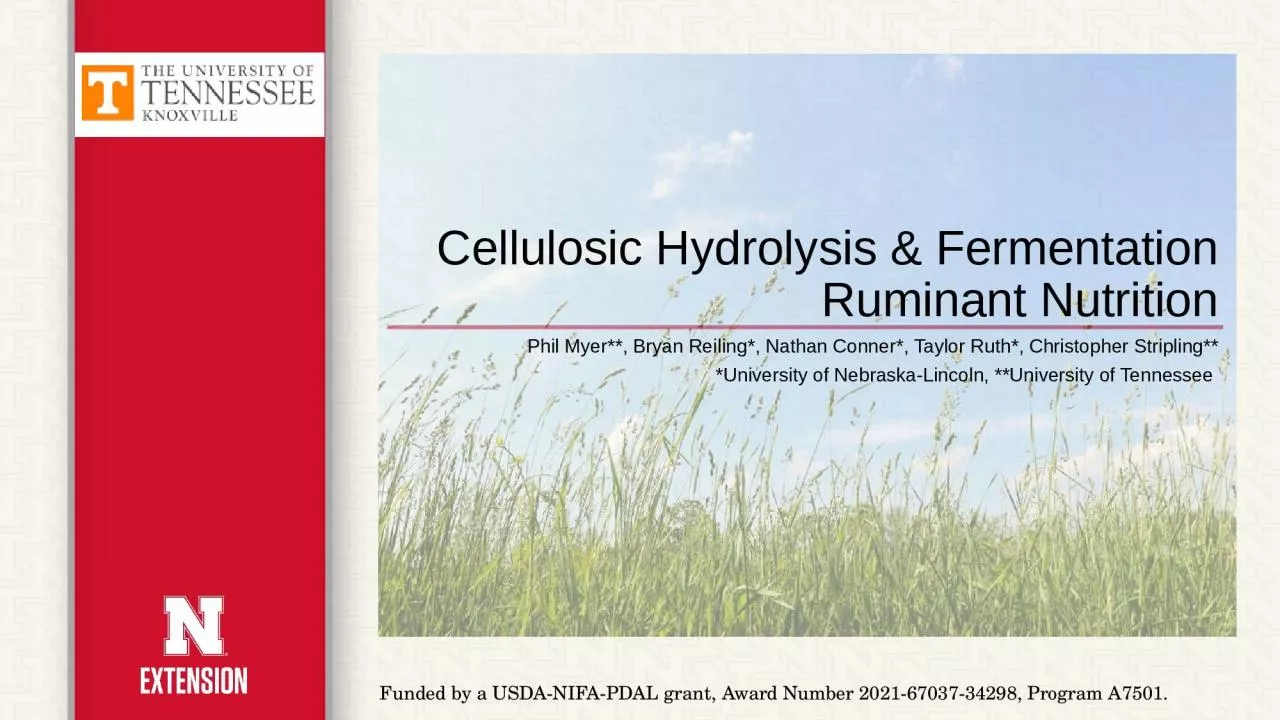

Ruminant Nutrition Phil Myer Bryan Reiling Nathan Conner Taylor Ruth Christopher Stripling University of NebraskaLincoln University of Tennessee Funded by a USDANIFAPDAL grant Award Number 20216703734298 Program A7501 ID: 1030209
Download Presentation The PPT/PDF document "Cellulosic Hydrolysis & Fermentation" is the property of its rightful owner. Permission is granted to download and print the materials on this web site for personal, non-commercial use only, and to display it on your personal computer provided you do not modify the materials and that you retain all copyright notices contained in the materials. By downloading content from our website, you accept the terms of this agreement.
1. Cellulosic Hydrolysis & FermentationRuminant NutritionPhil Myer**, Bryan Reiling*, Nathan Conner*, Taylor Ruth*, Christopher Stripling***University of Nebraska-Lincoln, **University of Tennessee Funded by a USDA-NIFA-PDAL grant, Award Number 2021-67037-34298, Program A7501.
2. CarbohydratesPrimary function = ENERGYGreatest % of balanced dietWhat is the difference?Glucose, Starch, & Cellulose
3. Types of CarbohydratesGlucose – simplest of all sugarsAll CHO’s glucoseStarcha - linkages of several glucose moleculesCellulose (structural CHO)b - linkage of several glucose moleculesprimary user of cellulose = RUMINANT
4. What is Cellulose?
5. Nutritional Physiology TerminologyDigestionPreparation of food for absorptionReduction in food particle sizemechanical - chewingchemical - HCl, bileenzymatic – lipase, pepsinmicrobial
6. Ruminant Digestive System“Pre-gastric fermentation”Mouth - functions to reduce particle sizeInitial mastication (chewing)Rumination (cud chewing)Regurgitation – caused by reticulumRemasticationMore salivaReswallowing
7. Ruminant Digestive SystemReticulum – the “honeycomb”Forces the “cud” back to the mouthReticulum
8. Ruminant Digestive SystemRumen (~50 gallon capacity, mature cattle)StoragePhysical mixingFermentation chamberRumen
9. Ruminant Digestive SystemSymbiotic Relationship ANIMALProvides the perfect home for microbesVFAs (acetate, butyrate, propionate)absorbed through rumen wallserve as an energy source for the animalDigest microbes to retrieve protein & vitaminsMICROBEUse diet energy (CHO) and N for own growthExcrete VFAs as a waste productPappillae
10. Ruminant Digestive SystemOmasum – “manyplies”; “Stockman’s Bible”Absorption of waterOmasum
11. Ruminant Digestive SystemAbomasum (true stomach)Acidic digestionSmall and Large Intestinessame as for monogastricAbomasum
12. How is ethanol made?Fermentation of sugars from plants4www.glbrc.orgSugars (glucose) + yeast ethanol + carbon dioxide
13. What can be used to make sugars for fermentation?www.glbrc.org7PlantsSugars (glucose)Ethanolsugarcellulosestarch
14. Sources of celluloseCorn stalks, leaves, and husks (stover)Grasses, grown as cropsPrairie grassesSawdust and woodchipsYard wasteAny plant!
15. “Loosened” cell wall material(cellulose hemicellulose, lignin)RuminationPretreat (grinding, heating)EnzymaticDigestionGlucoseGrowthSugar CaneCorn (grain)StarchGlucoseGrowthNon-RuminantDigestionCellulosic MaterialGlucoseMicrobial DigestionCellulaseEthanol / VFAs GrowthMicrobial FermentationProcess for MakingCellulosic Ethanol: Overview
16. Step 1: PretreatmentBreak down plant cell walls to release celluloseSimulating Rumination
17. Step 2: Enzyme Digestion HydrolysisCellulase enzymes: cellulose glucoseCelluloseMicrobialEnzymeGlucoseGlucoseGlucoseGlucose
18. Step 3: FermentationAnaerobic environment2 EthanolGlucoseYeast2 Carbon DioxideC02
19. Reflection QuestionsDid you observe any changes in glucose concentrations after the enzyme hydrolysis stage? Explain.Did your results match what you expected would occur? Explain.Among all samples tested within the class, what biomass treatment produced the most glucose and ethanol? Why?Among all samples tested within the class, what biomass treatment produced the least glucose and ethanol?If you were to try this experiment again to produce more ethanol, what would you do differently?
20. Application QuestionsWhat basic scientific principles are associated with rumen fermentation and nutrient utilization?Given your results, what are the production & potential economic impacts of feed processing on nutrient utilization, feed efficiency, and cost of gain?Would this be the same for all animal types, or just ruminants?What are the pros and cons of harvesting and feeding forages of greater maturity to ruminant animals?
21.